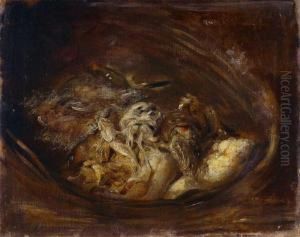Ernst Zimmermann Paintings
Ernst Zimmermann was a German painter born on January 23, 1852, in Munich, Germany. He showed an early aptitude for art and was enrolled in the Munich Academy of Fine Arts, where he was a student of historical painting under the guidance of professors such as Wilhelm von Diez and Franz von Defregger. Zimmermann's style was influenced by the Munich School, which was known for its detailed realism, strong use of color, and often genre scenes from Bavarian life.
During his career, Zimmermann was primarily known for his historical and genre scenes. He excelled in depicting moments from the Middle Ages and the Renaissance, bringing a sense of drama and authenticity to his recreations of historical events. His works were characterized by meticulous attention to detail and a penchant for capturing the textures of fabrics and the interplay of light and shadow.
Zimmermann's reputation grew as he exhibited his works in various exhibitions, including the prestigious Munich Art Exhibition and other venues across Germany. Despite his focus on historical themes, he was also known to produce portraits and religious art, demonstrating versatility across different genres.
Tragically, Ernst Zimmermann's life and career were cut short when he died unexpectedly at the age of 49 on December 6, 1901, in Munich. His untimely death meant that his artistic potential was never fully realized, and while he was respected during his lifetime, he did not achieve the same enduring fame as some of his contemporaries. Nevertheless, his contributions to the Munich School and his finely crafted paintings have ensured that he is remembered as a skilled artist of the late 19th century.
